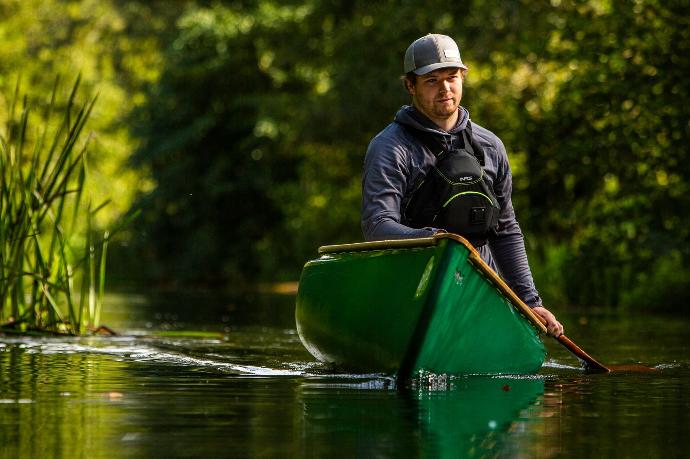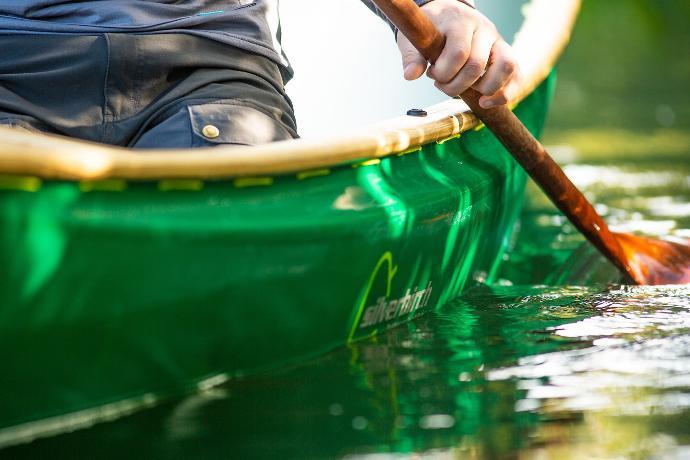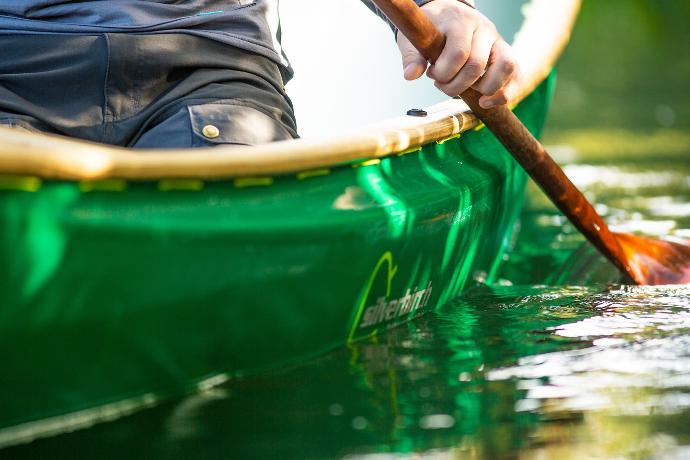Even as a novice, we can appreciate the feel of a higher-end paddle, whether that's for the weight and balance, the materials and aesthetics, the way the blade slices through the water, or a connection with tradition.
WHY CHOOSE A HIGH-END PADDLE?
Even as a novice, we can appreciate the feel of a higher-end paddle, whether that's for the weight and balance, for the materials and aesthetics, for the way the blade slices through the water, or for a connection with tradition.
Many enthusiasts prefer a lighter, stiffer paddle, and look for one weighted blade-light, or at least one weighted evenly around the lower hand.
If we get into different environments, perhaps even swapping to different boats, we may even find ourselves with a variety of higher-end paddles… perhaps choosing two contrasting options for each outing.

We might even end up with a custom-made paddle that's unique to us!
The range of high-end paddle options available today is immense… but in practice, our preferences for materials and purpose rapidly narrow the field to a few, easily compared options.

ONE-PIECE WOODEN PADDLES
High-end wooden paddles which are marketed as "traditional" may be shaped from a single, hand-picked length of timber. This may be augmented on the tips by a wear-resistant insert, but the material will be otherwise consistent.
Refinement in a more traditional, single-timber paddle is typically evident in crisp edges and a double camber (cross section), but also in an oval paddle-shaft and perhaps in a custom grip (sized to the paddler).
Flex is commonly savoured when present in higher-end one-piece wooden paddles. Enthusiasts may enjoy coming to know the unique feel of their own paddle, and may actively seek to replicate that feel in replacement paddles.
Improved balance in a single-timber paddle typically achieved through a smaller blade. As a rule, smaller blades encourage a good stroke and a higher cadence (stroke rate). Those seeking a larger blade area (e.g. for downwind sailing or for advanced whitewater) might have to accept a less balanced one-piece paddle.
Sharp edges and a "double camber" cross section on traditional paddles become most noticeable when we want water to flow neatly on either side of a blade. A more refined blade will be allow greater loading before turbulence compromises performance.
LAMINATED WOODEN PADDLES
Utilising the contrasting characteristics of different hardwoods allows paddle-makers to craft paddles with otherwise-unobtainable aesthetics, weight distributions, and performance characteristics.
Laminations may be used to produce slender, traditional paddles which perform as well as single-hardwood paddles weighing 50% more.
As a rule, laminated paddles will at least be varnished in a way that protects the glued joints. In practice, most laminated blades are finished with a lightweight fibreglass cloth to protect the surface from minor abrasions.

Red cedar is a classic option for adding volume to a paddle with minimal increase in weight. Alternatives such as maple or cherry may be added for stiffness and strength. Other timbers commonly used, for one reason or another, include sitka spruce, basswood and black walnut.
Paddle makers have come up with many ways of reinforcing key wear points such as the tips of paddles. Solutions range from laminating with more durable hardwoods through laminating in reinforcement to finishing edges with a specially optimised synthetic material.

HIGH END COMPOSITE PADDLES
At the top end of the market, we’re most commonly looking at paddles made of carbon fibre cloth impregnated in epoxy, or at pre-impregnated carbon fibre.
If we’re after a more performance orientated paddle for open water, we are likely to be seeking reduced blade-weight, but with the right construction, even ultra-tough white water blades can weigh in at less than 570g (20 oz).
Where overall weight is our aim, buoyant, foam-cored straight touring paddles can come in at under 370g (13 oz). If balance is more critical, we may combine technologies, perhaps with a composite blade on a wooden shaft.
High end paddles for white water may be indistinguishable from paddles used in canoe slalom or in rafting. Conventional (symmetrical) blades may be preferred, but curved or spooned blades are more commonplace. Blade shapes may be aggressively squared off or rounded. Paddle tips and edges may be reinforced.
Bent-shaft paddles are more commonly seen in carbon than in any other material, but also range in design focus and weight. Some are very much aimed at touring whilst others are very much pitched at those competing in events within the Triple Crown of Canoe Racing.
GRIPS, PADDLE SHAFTS AND FINISHES
Even with high end paddles, we may find our options limited to conventional Pear Grips and T-Grips, but we may also find Asymmetric or Offset grips, or an Algonquin or Northwoods Grip.
Custom grips can be variants on any standard grip, and can be carved to fill a specific hand and to suit a particular paddling style.
Shaft diameters and shapes can vary even with off-the-shelf paddles. Oval shafts may even be tapered. This is commonplace with high end wooden paddles, but can also be found in select composite paddles.

At the most radical end of paddle designs, we find double-bent shafts with offset grips. These can be used perfectly well by either novices or advanced canoeists, and devotees may claim they are kinder on wrists. Double bends are very much a matter of personal taste.
Paddle finishing is very much a matter of taste, but at the higher end, oiled wooden grips may even be found on paddles with composite (e.g. carbon fibre) shafts and blades. Paddle protection also becomes more commonplace, with fabric bags used when transporting paddles.


